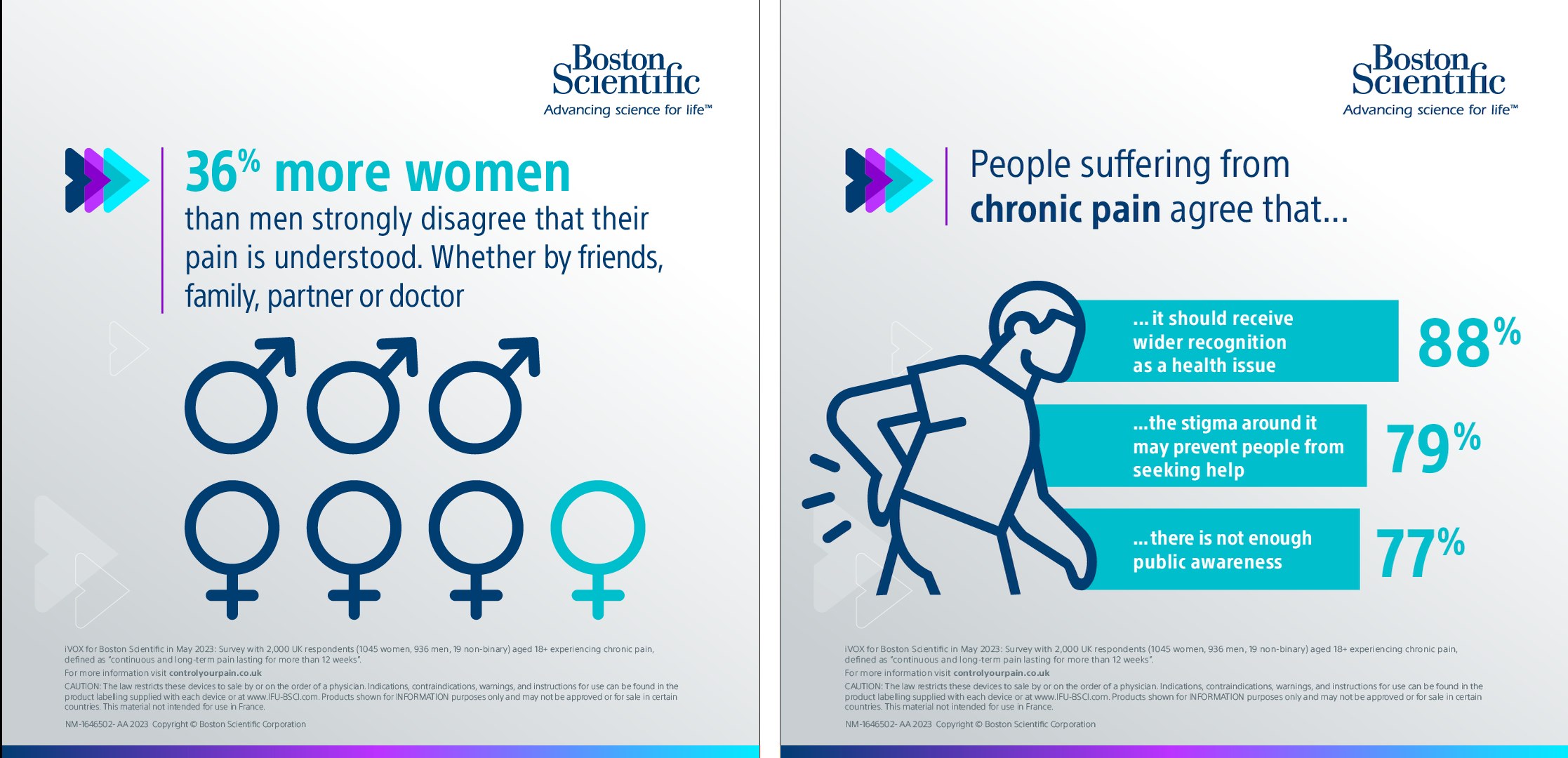Pain Awareness Month - Chronic Pain Survey Reveals Challenges Faced by Patients

19 September 2023
Survey in the UK and Germany points to a difference in the experience of chronic pain, pursuing pain relief and the feeling of being understood, between genders and different age groups
Chronic pain is a common health issue and affects one in five adults in Europe.1 While acute pain, which occurs immediately after an injury – such as a burn or broken bone - typically lasts no longer than two months when treated properly, chronic pain is defined as a continuous and long-term pain lasting for more than 12 weeks.2 It can persist for months or even years and can be very difficult to treat.3 September is pain awareness month – a month to shine a light on the many challenges those affected have to face, but also a time to show that with the right treatment, long-term pain relief can be achieved.
For the third year in a row, Boston Scientific has commissioned a survey of people experiencing chronic pain, to learn more about their chronic pain journey and identify barriers affecting treatment. It was conducted in May 2023 by research house iVOX, and canvassed 2,000 respondents with chronic pain in the United Kingdom (UK) and a further 1,000 in Germany.
This year’s survey revealed some striking gender differences in the experience of chronic pain, pursuing pain relief and the feeling of being understood, as well as significant differences between age groups in both countries. In both countries, many of the challenges are similar, and point to the fact that general public and the health care system would benefit from more awareness about chronic pain, to ensure people are getting the help they need.
In both the UK and Germany, younger respondents with chronic pain (18-34 years old in the survey) are about twice as likely to experience undiagnosed chronic pain (47% in the UK, 43% in Germany) than those over 65 (25% in the UK, 21% in Germany). Younger people are also revealed to be twice as likely to self-medicate with over-the-counter medication than older people with chronic pain (47% vs 24% in the UK; 44% vs 25% in GER). Since taking pain killers over a prolonged period of time can carries the twin risks of addiction and a diminished ability to function, a physician should be contacted to determine the treatment option that will work best.
The survey also points to obstacles for seeking help, and sometimes those are internal. The main reason young people in the UK gave as to why they do not seek help is because they think that everybody suffers from something, while in Germany the number one reason was simply a lack of time. The lack of information also features as a barrier for finding solutions with four in ten German respondents between 18-34 years old stating that they do not know where to seek professional help, compared to 24% among those over 55. In the UK the difference is even larger, with half of younger respondents giving that reason, compared to just under one in five of more senior respondents.
Gender differences in the experience of chronic pain
Women with chronic pain feel noticeably less understood than men by their partner, friends, or family when it comes to their health issue – in both countries. On average across all these groups 36% more women than men in the UK disagreed with the notion that the full extent of their pain is understood, in Germany that discrepancy was 29%. Even when talking to a healthcare professional, women are less likely to feel understood than men, with over 40% of female UK respondents noting that they do not feel understood by their doctor (compared to 25% with men). In Germany a striking 28% of women who have not sought help think that their doctors will not take them seriously, compared to only 4% of male respondents.
All genders and age groups however agreed with the statement that chronic pain deserves more awareness and there should not be stigma attached to it. If you are interested in learning more about treatment options, and to search for a pain center near you, visit: https://www.bostonscientific.com/en-EU/health-conditions/chronic-pain.html
[1] Policy Connect. About Chronic Pain. https://www.policyconnect.org.uk/cppc/about-chronic-pain Accessed March 2012.
[2] Mills S, Torrance N, Smith BH. Identification and Management of Chronic Pain in Primary Care: a Review. Current Psychiatry Reports. 2016;18:22. doi:10.1007/s11920-015-0659-9. https://www.ncbi.nlm.nih.gov/pmc/articles/PMC4731442/
[3] Brunton S. Approach to assessment and diagnosis of chronic pain. J Fam Pract. 2004;53(10 Suppl):S3-10. Accessed at : https://findarticles.com/p/articles/mi_m0689/is_10_53/ai_n6249279/?tag=content;col1.
###
This material is for informational Purposes only and not meant for medical diagnosis. This information does not constitute medical or legal advice, and Boston Scientific makes no representation regarding the medical benefits included in this information. Boston Scientific strongly recommends that you consult with your physician on all matters pertaining to your health.
CAUTION: The law restricts these devices to sale by or on the order of a physician. Indications, contraindications, warnings, and instructions for use can be found in the product labelling supplied with each device or at www.IFU-BSCI.com. Products shown for INFORMATION purposes only and may not be approved or for sale in certain countries. This material not intended for use in France. 2023 Copyright © Boston Scientific Corporation or its affiliates. All rights reserved.
Results from different clinical investigations are not directly comparable. Information provided for educational purposes only.